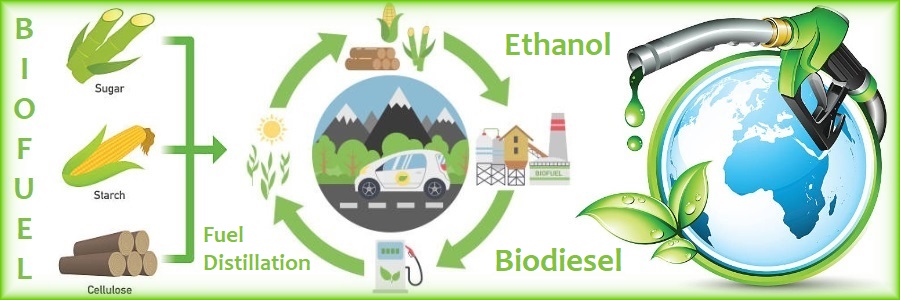Fuel Still Ingredient Recipes
Brewing up your own Bio-Fuel is a great way to lower your petrol costs and be a good steward of the earth with green, environmentally friendly practices for renewable energy.
Ethanol Fuel Production
Equipment and materials used to create ethanol
- 20 gallon plastic barrel with a lid
- 10 ounce packet of brewer yeast or distiller yeast
- One stirring paddle
- Forty pounds of sugar
- Column Reflux Still
Corn Based Ethanol Fuel Ingredients Recipe
- Quality tested corn, ground into flour
- Mix well with hot liquids and enzymes
- this converts the starches into sugar for fermenting
- Add yeast to newly converted sugars mixture
- this will turn it into alcohol as the carbon dioxide gathers at the top of the fermenting tank
- Pump mixture of solids, alcohol and water (“beer mash”) into tanks
- Heat until gravity separates the liquids from the solids
- Use molecular sieve to separate water from the alcohol
- this creates 200 proof grain alcohol – also known as ethanol
- Separate out your by-products, – carbon dioxide and dry distiller’s grains, – save for later use (both can be sold separately)
- Finally, poison your ethanol with a little dab of natural gasoline
- a federal requirement to differentiate it from drinking alcohol
Ethanol Product Result:
95 percent pure ethanol that can used as is, or blended with gasoline and sold as E85 or E10
Producing Ethanol From Starches
Wheat, Corn, Rye, Barley, Milo, Rice, Cattails
Starch Ethanol Production:
- Grind your starch product into a fine meal using a 3/16" screen on a hammer mill; add 30 gal. water per bushel
- Additives (Enzymes): Add 3 spoons mash cooking powder per bushel
- Preboil: Raise temp. to 170 deg F for 15 minutes, agitate vigorously
- Cook: Hold at rapid rolling boil for 30 minutes
- Cool Down: Cool with coil to 170 deg F; add 3 spoons mash cooking powder and agitate for 30-60 minutes
- Culture: Reduce temperature to 90 deg F, add 6 spoons mash fermenting powder, agitate for 10 minutes, cover
Results: 9% alcohol. Wheat, rye, and barley may cause foaming: Use Low-FoaM or mix with cornmeal.
Biodiesel Fuel Production
Making biodiesel fuel from used cooking oil. Restaurant waste vegetable oil (WVO), used fryer grease, animal fats, lard, are great ingredients for making biodiesel fuel. Plus, this type of restaurant waste is often free for the taking.
With a few common chemicals, and some equipment you can easily buy or make yourself, this leftover waste can be transformed into a powerful equipment firing petrol. This transformation result becomes a cheap, non-toxic, clean-burning, high-quality diesel motor fuel you can use without modifications.
With this type of renewable energy, it's hard not to appreciate its economic and green global friendly characteristics.
Warnings For You To Use Caution
Protect yourself from the elements. Eye protection, gloves, apron, mask - don't inhale the vapors! Beware, methanol absorbed through the skin or drank can cause blindness and death. Sodium hydroxide can cause severe burns and death. Together these ingredients form an extremely dangerous and caustic chemical called sodium methoxide.
Work in a thoroughly ventilated workspace with safely features like a water hose and fire extinguisher for safety purposes.
Making Biodiesel Fuel
Biodiesel Fuel Ingredients Recipe Mixture:
- Waste vegetable oil (WVO) cooking oil, fryer grease, animal fats, lard
- Methanol (CH3OH) -- 99%+ pure
- Sodium hydroxide (NaOH -- caustic soda, lye) -- must be dry
Titration:
- Isopropyl alcohol (rubbing alcohol) -- 99%+ pure
- Distilled water
- Phenolphthalein solution (not more than a year old, kept protected from strong light) -- "Phenol" or "Phenol Red", a pool or hot tub supply may not be the same as phenolphthalein, but it can be used though the directions for use may vary.
- Vinegar
- Water
Procedure to Transform The Waste Vegetable Oil to Biodiesel:
- Run WVO through a Filter to remove food scraps and solid particles
- Heat WVO up to remove water content (optional)
- Perform titration to determine how much catalyst is needed
- Prepare sodium methoxide
- Heat WVO, mix in the sodium methoxide while stirring
- Allow to settle, remove the glycerine
- Wash and dry
- Check quality

